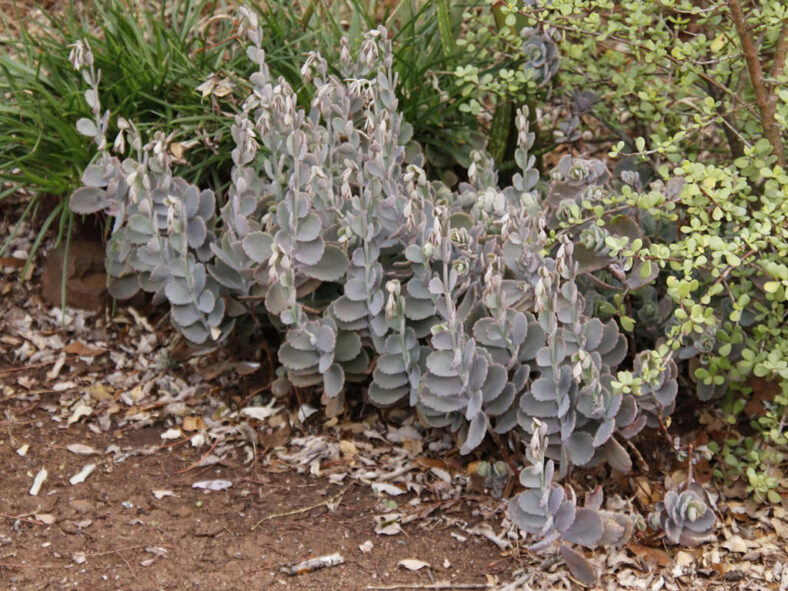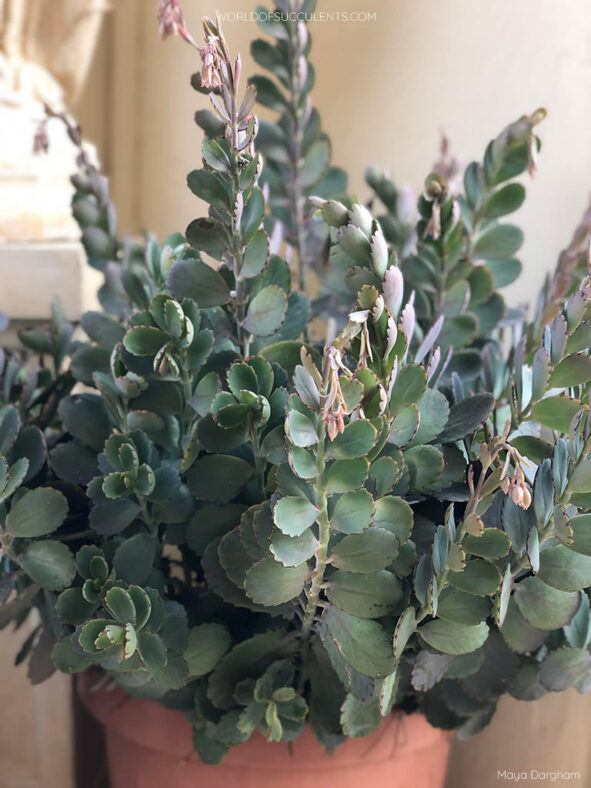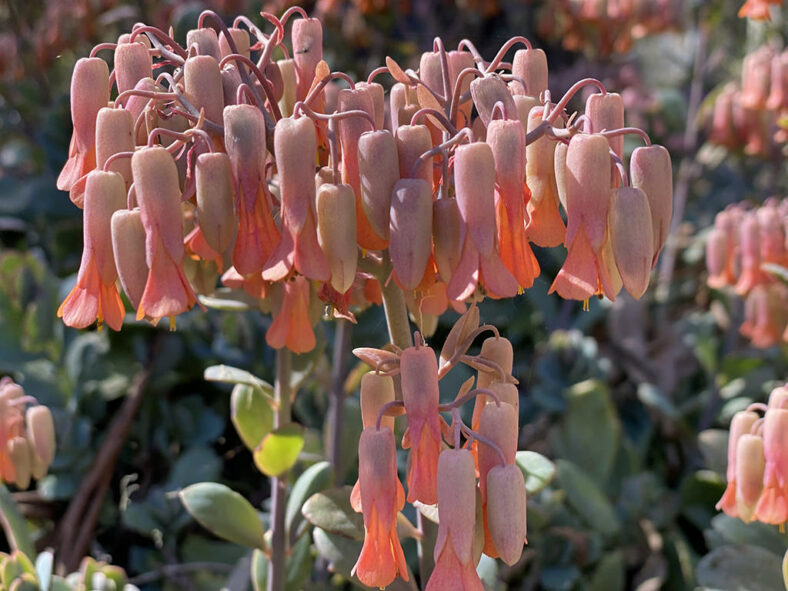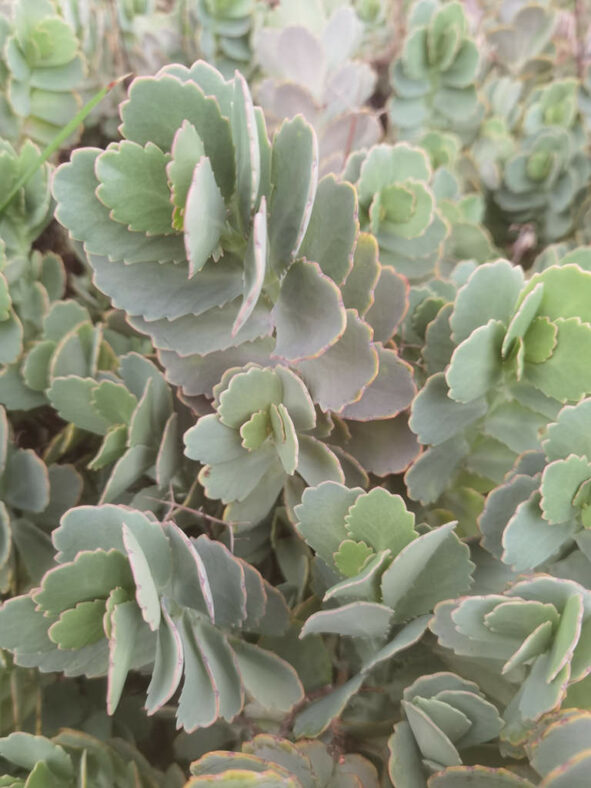Native to Madagascar, Kalanchoe fedtschenkoi is widely grown in gardens and as a houseplant. This plant has also naturalized in the wild in some parts of Africa, Tropical Asia, Europe, North America, and South America.
Scientific Name
Kalanchoe fedtschenkoi Raym.-Hamet & Perrier
Common Name(s)
Kalanchoe Stonecrop, Lavender Scallops
Synonym(s)
Bryophyllum fedtschenkoi
Scientific Classification
Family: Crassulaceae
Subfamily: Sedoideae
Tribe: Kalanchoeae
Genus: Kalanchoe
Etymology
The specific epithet "fedtschenkoi" (pronounced "fed-tscheng-koh-eye") honors Boris Alexeevich Fedtschenko (1872-1947), a Russian plant pathologist and botanist.
Origin
Kalanchoe fedtschenkoi is native to central and south-eastern Madagascar. It grows on siliceous rocks at elevations that range from 330 to 3,280 feet (100 to 1,000 m). The plant has also established itself in the wild in some parts of Africa, Tropical Asia, Europe, North America, and South America.
Description
Kalanchoe fedtschenkoi is a succulent plant that forms clumps of slender, much-branched stems with fleshy, distinctly waxy leaves, often with reddish-purple margins. It can grow up to 20 inches (50 cm) tall. When young, the stems are green to greenish-purple, turning brown to purplish-brown or purple with age. They are erect or creeping and easily root along the way. The leaves are densely packed in young plants, later becoming more widely dispersed and usually located in the upper part of the stems and branches. They are obovate or obovate-oblong to nearly round, measuring up to 2 inches (5 cm) in length and 1 inch (2.5 cm) in width. The margins of the leaves are scalloped, typically in the upper half, and often carry plantlets, especially after the leaves are detached. The leaves are attached to the stem by a petiole up to 0.5 inches (0.5 cm) long.
From late spring to early summer, Kalanchoe fedtschenkoi produces pendent, bell-shaped flowers in many-flowered, head-shaped clusters. The inflorescence is erect, sometimes bulbiferous after flowering, and can reach a height of up to 8 inches (20 cm). The flowers can measure up to 0.8 inches (2 cm) in length and have a yellow-green calyx with numerous red, purple, or blue lines and an orange-red corolla with many red lines. The fruits are light green follicles covered by persistent flower parts. They can grow up to 0.3 inches (0.8 cm) long and contain tiny, dark brown to reddish-brown seeds.

Cultivars of Kalanchoe fedtschenkoi
How to Grow and Care for Kalanchoe fedtschenkoi
Light: Kalanchoe fedtschenkoi grows best in full sun but usually appreciates some partial shade during the hot summer days. When growing indoors, place it near a window with indirect sunlight. If it does not receive enough light, it may stretch.
Soil: The plant needs soil that drains well and does not like "wet feet." A commercial potting mix for succulents will work well.
Temperature: Kalanchoe fedtschenkoi thrives in heat and humidity but cannot handle frosts. It grows best in USDA Plant Hardiness Zones 9b to 11b, with average minimum winter temperatures ranging from 25°F to 50°F (-3.9°C to 10°C).
Watering: From spring to fall, water the plant thoroughly, but allow the soil to dry between waterings, as overwatering can cause stem rot. Reduce water during winter and only water it enough to prevent the leaves from shriveling.
Fertilizing: To ensure the plant has the necessary nutrients to thrive, fertilize it occasionally during the growing season with a balanced fertilizer. Dilute the fertilizer to half or quarter strength and apply it every two weeks.
Repotting: The plant thrives better when frequently repotted. For optimal growth, repot it every two years in the spring, using a pot one size larger than the previously used one.
Propagation: Kalanchoe fedtschenkoi can be easily propagated by plantlets that develop along the leaf margins. Spring is the best time to separate the plantlets.
Learn more at How to Grow and Care for Kalanchoe.
Toxicity of Kalanchoe fedtschenkoi
Kalanchoe fedtschenkoi is not toxic to people but should be kept away from pets because, if consumed, it may cause vomiting, diarrhea, and heart arrhythmias.
Links
- Back to genus Kalanchoe
- Succupedia: Browse succulents by Scientific Name, Common Name, Genus, Family, USDA Hardiness Zone, Origin, or cacti by Genus
Photo Gallery
Click on a photo to see a larger version.


